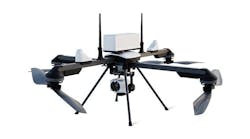Nov. 19—Inspecting oil and gas sites in a cost-effective manner is advancing along with the use of drone technology.
American Robotics not only showcased its drone-in-a-box at the Hart Energy Executive Oil Conference but highlighted the fact that its Scout System is autonomous — allowed by the Federal Aviation Administration to operate without a human pilot.
"It changes the economics of human deployment," said Jason Cornell, vice president, product. It allows the company's clients to more efficiently deploy their pumpers who would otherwise spend their time driving to lease sites or operators who have to be on site operating inspection drones, he explained.
Being autonomous, Cornell said the drone is capable of monitoring its airspace for other aircraft and taking evasive action.
The Scout System is comprised of a base station set up on a site that allows the drone to fly up to a 2-mile radius and inspect assets multiple times per day. Inspections range from loss of containment — either oil or water — fugitive emissions and the security of the site. The drone returns to the base to recharge and as it recharges, it downloads the data it collected into a computer that analyzes it for anomalies and then the data is transferred to a portal the client can access.
"It allows them to focus on critical instances so they can optimize their remedial efforts," said Cornell.
The value to the client is significantly reduced expenses, reduction of reputational risk from damage caused by spills or emissions or by non-compliance with regulations, and reduction of safety risks, he continued.
The number of base stations required depends on the scope of the facilities the client wants inspected. Cornell said his company is working with one client that has 3,000 well pads to inspect — requiring an estimated 50 base stations.
The threshold for facilities to inspect is at least 10 to 15 well pads, he said.
American Robotics manufactures its drones and base stations and works with customers "to understand their needs and work those into our manufacturing plans" before manufacturing the equipment. The company plans to add a high-resolution RGB and thermal camera payload and Optical Gas Imaging camera as well to better inspect upstream and midstream assets from pumping units and heater treaters to flare stacks and more.
The company has worked in other industries, but Cornell sees incredible opportunities in the oil and gas industry.
Especially, he said, as proposed new regulations are expected to mandate more frequent and repeatable inspections.
___
(c)2022 the Houston Chronicle
Visit the Houston Chronicle at www.chron.com
Distributed by Tribune Content Agency, LLC.

